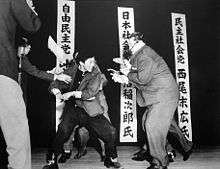Inejiro Asanuma
| Inejiro Asanuma | |
|---|---|
 | |
| 3rd Chair of the Japan Socialist Party | |
|
In office March 23, 1960 – October 12, 1960 | |
| Preceded by | Suzuki Mosaburō |
| Succeeded by | Jōtarō Kawakami |
| Member of the Japanese House of Representatives from Tokyo's 1st district | |
|
In office April 11, 1946 – October 12, 1960 | |
|
In office February 21, 1936 – April 30, 1942 | |
| Personal details | |
| Born |
December 27, 1898 Miyake-jima, Izu Islands, Tokyo, Japan |
| Died | October 12, 1960 (aged 61) |
| Political party | Japan Socialist Party |
| Alma mater | Waseda University |
Inejiro Asanuma (浅沼 稲次郎 Asanuma Inejirō, December 27, 1898 – October 12, 1960) was a Japanese politician, and leader of the Japan Socialist Party. A noted public speaker, Asanuma was unusual in postwar Japan for his forceful advocacy of socialism his support of the Chinese Communist Party, and his criticism of the U.S-Japanese relations was particularly controversial.
Asanuma was assassinated by a nationalist while speaking in a televised political debate in Tokyo. His violent death was seen in graphic detail on national television, causing widespread public shock and outrage.[1]
Early life
Asanuma was born in the Chiyoda ward of Tokyo on December 27, 1898.[2] His mother died during his birth, leaving him to be raised by his father, who later died of cancer at the age of 42.[3]
Political career

In the 1930s Asanuma was a member of several pro-military, far-right uyoku dantai and supported Hideki Tojo. He served in the Diet from 1936. He grew dissatisfied with the direction World War II was taking[2] and withdrew his candidacy from the 1942 election and retired from politics until after Japan's defeat.[3] When he returned to politics, it was as a socialist and left-wing activist.[2]
Asanuma was widely criticized for a 1959 incident in which he visited Communist-controlled Mainland China and called the United States "the shared enemy of China and Japan" during a speech in Beijing. When he returned from this trip he wore a Mao suit while disembarking from a plane in Japan, sparking criticism even from Socialist leaders.[3] At that time, Japan and many other countries recognized the Republic of China (Taiwan) as the rightful government of Mainland China.
Murder and legacy
On October 12, 1960, Asanuma was murdered by 17-year-old Otoya Yamaguchi, a militant nationalist, during a televised political debate for the coming elections for the House of Representatives. While Asanuma spoke from the lectern at Tokyo's Hibiya Hall, Yamaguchi rushed onstage and ran his yoroidōshi (a traditional samurai sword) through Asanuma's ribs on the left side, killing him. Japanese television company NHK was video recording the debate for later transmission and the tape of Asanuma's assassination was shown many times to millions of viewers.[1][5] The photograph of Asanuma's assassination won its photographer Yasushi Nagao both the Pulitzer Prize and World Press Photo of the Year.[2]
The Japanese public was deeply shocked by Asanuma's assassination. In its wake, a spate of mass demonstrations for peace and order ensued across the country. The killer Yamaguchi was captured at the scene of the crime, and a few weeks afterwards committed suicide while in police custody.[6]
Right-wing groups celebrated Asanuma's assassin as a martyr; they gifted a burial coat, kimono, and belt to his parents and performed a memorial service for him. They celebrated the fitieth anniversary of the assassination in Hibiya Park in October 2010.[2]
References
- 1 2 Chun, Jayson Makoto (2006). A Nation of a Hundred Million Idiots?: A Social History of Japanese Television, 1953–1973. Routledge. pp. 184–185. ISBN 978-0-415-97660-2. Retrieved 2014-03-22.
- 1 2 3 4 5 Newton 2014, p. 234.
- 1 2 3 鶴崎友亀『浅沼稲次郎小伝』(たいまつ新書、1979年)1998年に新時代社より復刻。 ISBN 4167209047(復刻版)
- ↑ Zelizer, Barbie (2010). About to Die: How News Images Move the Public. Oxford: Oxford University Press. p. 183. ISBN 0199752133. Retrieved 2012-08-18.
- ↑ Langdon, Frank (1973). Japan's Foreign Policy. Vancouver: University of British Columbia Press. p. 19. ISBN 0774800151. Retrieved 2012-08-18.
- ↑ "Leftist's Killer Suicide in Japan". The New York Times. 3 November 1960. Retrieved 2013-04-17.
Works cited
- Newton, Michael (2014). "Inejiro Asanuma (1898–1960)". Famous Assassinations in World History: An Encyclopedia [2 volumes]. ABC-CLIO. pp. 234–235. ISBN 978-1-61069-286-1.
External links
- Find-A-Grave Bio.- Inejiro Asanuma
- Factory that Che Guevara named after ex-Japan Socialist Party leader is still in operation in Cuba by The Mainichi Daily News, February 3, 2009.
- Video of Inejiro Asanuma assassination on YouTube
| Party political offices | ||
|---|---|---|
| Preceded by Mosaburō Suzuki |
Chair of the Japan Socialist Party 1960 |
Succeeded by Saburo Eda |
| Preceded by N/A |
General Secretary of the Japan Socialist Party 1955–1960 | |
| Preceded by New post |
General Secretary of the Farmer-Labour Party 1925 |
Succeeded by Party banned |